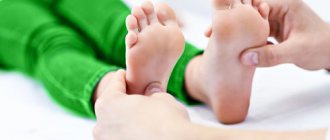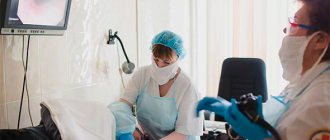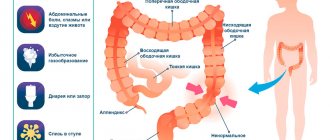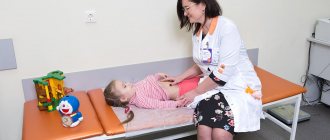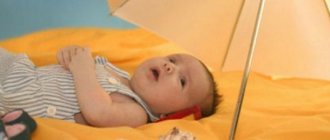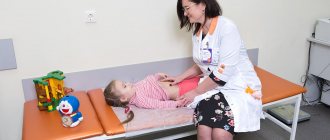Acute abdominal pain can be caused by a variety of physical and emotional causes. Fortunately, it often goes away on its own, without special treatment. But parents should be able to identify situations where the cause of acute abdominal pain may be serious.
URGENT CARE
Call an ambulance if:
- constant pain lasting more than 2 hours
- in boys, pain is accompanied by swelling of the scrotum and enlargement of the testicles
- the child's pain persists an hour after vomiting or loose stools
- one place in the abdomen is very painful with slight pressure
- The child has yellow-green vomit or blood in the stool
THE DOCTOR'S CONSULTATION
Contact your doctor if:
- a child under one year old has signs of abdominal pain (unusual crying, pulling the legs towards the stomach)
- abdominal pain is accompanied by fever, nausea, vomiting, and upset bowel movements
- the child looks sick
- abdominal pain recurs frequently
ATTENTION!
Do not force your child to eat if he has abdominal pain, but do not forbid him to drink mineral water or tea if he wants. Do not give painkillers until examined by a doctor!
| ASK YOURSELF A QUESTION | POSSIBLE REASON | WHAT TO DO |
| Does your child have diarrhea or vomiting? | Gastroenteritis | Call your pediatrician (or gastroenterologist ). Monitor your child carefully until the doctor arrives. Stop feeding temporarily. Wait two hours before the last vomiting; then give a cool drink often and little by little (1 teaspoon - 1 tablespoon every 10 minutes). For a child over one year old, it is best to give solutions for the treatment of dehydration sold in pharmacies (Rehydron, Oralit). Gradually increase the amount of liquid. Let the child just drink for a while; then start breastfeeding or formula feeding again (allow older children to eat light foods), after which you can move on to a regular diet. |
| Does your child often complain of abdominal pain and feel normal in between pains? Is he 4 years old or older? | Nonspecific abdominal pain, often associated with stress (see Chronic or recurring abdominal pain). | Lay your baby on his back to help him relax and offer him something to drink. Check for any warning signs. Consult with your pediatrician to rule out a serious illness, he will tell you how to avoid factors that provoke abdominal pain. |
| Does your child not even let you touch his stomach? | Gastroenteritis or, if the pain lasts more than 2 hours, abdominal surgery such as appendicitis | If the condition improves, give drinks and then eat when the child is able and willing to eat. If diarrhea begins, call a doctor and act as for gastroenteritis (see above). If the pain lasts more than 2 hours, call an ambulance |
| Constant pain lasting 2 hours or more? Did it start near the navel and then move down the abdomen? | Appendicitis | Call an ambulance . Before being examined by a doctor, do not give anything to drink or eat. If the diagnosis is confirmed, hospitalization will be required. |
| Does a child over 3 years old also complain of sore throat and other pain, for example in the ear? | Viral infection, or streptococcal sore throat | Call the pediatrician . Let's drink. |
| There are at least two of the following symptoms: temperature more than 38°C; bedwetting (which was not there before); frequent, painful urination, unpleasant odor of urine? | Urinary tract infection | Call your pediatrician (or urologist ). You may need to get tested. You may also need to take antibiotics (see also Pain/difficulty urinating) |
| Was the vomit yellow-green in color? | Intestinal obstruction | Call an ambulance . Before being examined by a doctor, do not give anything to drink or eat. |
| Does your child have a painful lump in the groin or testicle area? | Strangulated hernia; testicular volvulus | Call an ambulance immediately |
FOR INFORMATION
Treatment of appendicitis
Appendicitis is an inflammation of the appendix, a vermiform appendage of the large intestine that is located near the junction of the small and large intestines. When abdominal pain and other symptoms indicate appendicitis, urgent surgery is required. If the inflamed appendix is not removed, it can burst open and cause peritonitis - inflammation of the entire abdominal cavity. After surgery, children usually recover quickly without complications.
Instructions for parents
If every parent knew what a variety of diseases are hidden under the ordinary children’s complaint “stomach ache,” I would not be surprised that even the most experienced doctors sometimes puzzle over the causes of this symptom. What is this: reluctance to go to school or a symptom of a serious illness? When to sound the alarm? How can you help your child get rid of discomfort and pain faster?
The first question that parents are usually interested in is: what does the child feel when he complains of abdominal pain?
Let's start with the fact that pain is a subjective sensation that occurs as a result of exposure to irritants that cause various disorders in the body. Even the fetus has the ability to perceive pain. As a result, the child feels the same burning, whining, tingling, and stinging sensations as adults, but due to his age he cannot always describe them.
So how can you figure out what exactly is hurting your child’s stomach? To understand this, one article is not enough, but let’s try to highlight the main reasons for this condition.
The very first thing the doctor will pay attention to when examining your child is age. The diagnostic search is based on one algorithm in the case of a five-month-old baby and completely differently if a sixteen-year-old boy comes to the appointment. Therefore, I propose to consider the possible reasons and tactics of parents’ actions in each period of childhood.
Causes of abdominal pain depending on the age of the child
If a child under one year old has a stomach ache, this may be due to the following problems.
Infants up to 6 months
In infants between one and six months of age, abdominal pain can be caused by:
- colic (air retention in the digestive system);
- stomach blockage;
- constipation
As a rule, a child with such ailments cries, sleeps poorly and often tosses and turns. Usually the pain goes away as the baby gets older.
Children over 6 months:
- gastritis, colitis, gastroenteritis (inflammatory processes of the stomach or intestines);
- inguinal hernia;
- respiratory tract diseases.
Such ailments are caused by infection and lead to pain in the upper abdomen, decreased appetite and vomiting. Treatment should be carried out only after consultation with a pediatrician.
Children under 7 years of age:
If a child under 7 years of age has a stomach ache, it may be due to the following:
- constipation;
- urinary tract infections;
- pneumonia;
- sickle cell anemia;
- poisoning.
Constipation is not always a cause for concern, but this problem may indicate that the child has digestive problems. Urinary tract infections make themselves felt by abdominal pain, fever and pain during urination. With pneumonia, the baby coughs and complains of chest pain, and anemia is characterized by pain in the back, chest and limbs. Poisoning in children usually occurs after eating low-quality food. At the first signs of poisoning, you should call a doctor and provide first aid to the child:
- Make sure your child drinks plenty of water;
- do not give anything to eat;
- give sorbents (for example, Filters) to remove toxic substances.
School age children:
- gastroenteritis;
- binge eating;
- viral and infectious diseases;
- abdominal injuries;
- pneumonia;
- urinary tract infections;
- sickle cell anemia;
- acute appendicitis;
- in girls - pain during menstruation, inflammation of the pelvic organs.
Newborns and infants
The most difficult category of children to diagnose.
They will not be able to show, describe or even hint to you where it hurts now, or whether it hurts at all. In this case, it is important to distinguish the transient state of the child from the pathological one. Transient states, that is, transient ones, are associated with the anatomical and functional immaturity of the digestive organs, the nervous system, the formation of intestinal microflora, and the formation of a sleep/wake rhythm.
In infants, especially the first 6 months of life, the most common functional disorders are regurgitation, infant colic and functional constipation. In more than half of children they are observed in various combinations, less often - as one isolated symptom. It should be noted that for a healthy child, regurgitation up to 5 times a day (volume less than 3 ml) and stool up to 5-6 times a day (without pathological impurities) are quite acceptable.
Infant colic is characterized by the “rule of three”:
- colic begins in the first three weeks after birth;
- lasts about three hours a day;
- mainly occur in children in the first three months of life.
Infant colic is observed from birth and lasts mainly until 4-5 months.
In some children they last up to 6-7 months. In this case, the general condition of the child is not disturbed; normal weight gain is noted. Among the pathological conditions that occur with abdominal pain, children of this age may develop congenital malformations of the gastrointestinal tract, enterocolitis, intussusception and volvulus, strangulated hernia, and urinary tract infection. Parents are usually alarmed by “reasonless” anxiety that does not go away after feeding and sleep. The baby wiggles his legs, blushes, tenses, and refuses to eat. It is important to assess the nature and frequency of stool and regurgitation.
The most common causes of abdominal pain in children
Colic
These are unpleasant sensations that are usually observed in infants under 4 months of age. With colic, the baby tightens his legs, screams loudly, tosses from side to side and strains his abdominal muscles. You can relieve colic with a warm diaper placed on your tummy or dill water. Many parents also know about this method of carrying a child in an upright position. If the pain is especially severe and the baby cannot sleep at night, the pediatrician may prescribe medication.
Constipation
This malaise is characterized not only by colic, but also by bloating. To eliminate discomfort, you will need an enema or a rectal suppository (with glycerin or sea buckthorn).
Crick
In this case, the baby feels acute pain while walking or when trying to sit up straight. Muscle strain occurs due to severe overexertion (for example, after vomiting or a coughing attack). At the same time, the child otherwise feels well and eats with appetite, i.e. He has no other unpleasant symptoms.
Intestinal obstruction
It occurs in babies 5-9 months old and is accompanied by nausea, vomiting and blood in the stool. You must consult a doctor immediately.
Flatulence (bloating) and gas
The baby begins to be capricious and restless, and his sleep worsens. During feeding, the child is distracted every now and then, and at the end of feeding he often burps. Often, gas formation indicates the presence of other, more unpleasant disorders in the baby’s body.
Worms
When infected with roundworms, the child experiences not very strong, but still regular pain. In addition, the baby may experience a headache or bloating. There is a belief that teeth grinding in a dream in children indicates the appearance of worms, but this is nothing more than a myth.
Individual food intolerance
Most often, children suffer from intolerance to milk and its derivatives. About half an hour after consuming such a product, the child’s condition worsens: he begins to experience severe pain and bloating, suffers from diarrhea, and sometimes vomiting.
Jaundice
This is a contagious and quite serious childhood disease in which the child feels severe pain in the right side. Additional symptoms include yellowing of the whites of the eyes and darkening of the urine. If such signs appear, you should immediately consult a doctor.
Inflammation of the testicles
Little boys sometimes suffer from this disease. As a rule, the child feels pain in the lower abdomen and groin area. This problem can be caused by an injury to the groin area, a hernia, or testicular torsion. In any case, prompt assistance from a pediatrician is required.
Pyelonephritis
This disease, on the contrary, occurs in girls and is provoked by inflammation of the renal pelvis. Pyelonephritis is characterized by acute and intense pain in the lower back, side or abdomen. In this case, the child often feels hot, weak and chills, complains of nausea and sweats profusely. In this case, an urgent visit to the doctor is required, since in severe cases of pyelonephritis only surgical intervention can help.
Gastroenteritis
This is an inflammation of the mucous membranes of the stomach and small intestine, which is viral, parasitic or bacteriological in nature. The child feels a dull pain in the abdomen and complains of diarrhea, nausea and fever. Gastroenteritis also requires an urgent trip to the doctor.
Appendicitis
Appendicitis (or inflammation of the appendix) is a disease that affects approximately 15% of children. The disease usually does not become active until the age of two, but appendicitis most often occurs in children aged 8 to 14 years. At the initial stage of the disease, the child feels a nagging pain in the right or lower abdomen, refuses to eat, and complains of weakness, vomiting and fever. The disease progresses quite quickly, and soon the abdominal pain becomes acute. Eventually, the walls of the appendix collapse and its contents enter the child's abdominal cavity, which is life-threatening. Urgent hospitalization and surgical intervention are required.
How can a parent help?
If the child has not passed gas or stool for a long time, and his stomach is tense, give him a gas tube.
If the child's condition does not improve or there is no passing of gas or stool, consult a doctor. In case of prolonged attacks of colic, the child is restless outside of an attack and has poor sleep, it is necessary to exclude neurological disorders that can aggravate the course of physiological intestinal colic. Frequent and profuse regurgitation is also a reason to consult a specialist in order to exclude surgical and neurological pathologies. Fever accompanying the pain syndrome requires professional observation and differential diagnosis.
Children of early and preschool age
At this age, children are also often unable to answer important anamnestic questions. However, they can still complain and point to their belly. In this category of children, the maturation of organs and systems has already occurred to a greater extent, but the immaturity of nervous regulation does not allow them to clearly localize the source of pain.
It is important to note that among the pathologies that cause abdominal pain syndrome, the leading ones in this age period are gastroenteritis, intestinal colic, mesenteric lymphadenitis, acute abdomen, blunt abdominal trauma and edematous scrotum syndrome. Don't be surprised by the latest diagnosis. It is not for nothing that the immaturity of nervous regulation was mentioned, and therefore in boys pain in the scrotum area can radiate to the lower abdomen. In view of this, do not hesitate to examine the genitals.
Gastroenteritis, sometimes incorrectly called "stomach flu", regardless of the cause, is usually accompanied by vomiting or diarrhea. Gastroenteritis resulting from infection may be accompanied by an increase in body temperature.
Intestinal colic is one of the most common reasons for going to the hospital to exclude surgical pathology. It manifests itself as severe cramping pain in the abdomen and occurs as a result of intense contractions of the distended intestinal wall. The causes of this condition in 95% of cases are irregular nutrition and errors in the diet.
Mesenteric lymphadenitis is an inflammation of the mesenteric lymph nodes against the background of the infectious process. By 5–7 years of life, the maximum development of elements of lymphoid tissue in the body and in the mesentery, in particular, is observed.
In case of intestinal diseases, favorable conditions are created for the absorption of toxic substances in the distal parts of the small intestine. The regional lymph nodes, which perform a barrier function, take the aggressive blow. Thus, the development of mesadenitis is associated with the penetration of infection and toxins into the lymph nodes.
What to do if your child has a stomach ache?
If you don’t break your knees, you won’t grow, says popular wisdom. Unfortunately, few people manage to grow up without abdominal pain. Sooner or later, every child starts to have a stomach ache. And then his parents have questions: what to do if the child has a stomach ache? Is it dangerous? When should you see a doctor immediately, and when can you wait a little?
We addressed these and other questions to the Deputy Chief Physician for Pediatrics of Clinic Expert Smolensk LLC, Alexey Alexandrovich Zakharov.
What could be behind a child’s abdominal pain?
Abdominal pain is one of the most common acute syndromes in pediatric practice,” says Alexey Alexandrovich. This is due to the fact that many concomitant diseases not related to diseases of the gastrointestinal tract, including acute respiratory viral infections and acute respiratory infections, otitis media and bronchitis, pneumonia and urinary tract infections are accompanied by abdominal pain in children. In this situation, it can be extremely difficult to exclude pediatric and surgical pathology. Moreover, the younger the child’s age, the more difficult it is to differentiate the diagnosis.
Abdominal pain may hide appendicitis, obstruction in different parts of the intestine, strangulated hernia, intestinal infection, functional disorders in the form of overeating, constipation, and helminthic infestation.
In older children, various autonomic disorders may manifest themselves in the form of abdominal pain. For example, a child can express his social dissatisfaction by simulating abdominal pain.
In teenage girls, the stomach may hurt during the formation of the menstrual cycle. Such pain may hide congenital pathologies - atresia of the vagina and uterus and their underdevelopment, disruption of the genital differentiation syndrome, as well as ovarian apoplexy due to hormonal imbalance.
A number of diseases that are not associated with viral or surgical etiology, but require immediate treatment, also manifest as abdominal pain. Among them is diabetes mellitus. Abdominal pain in diabetes mellitus occurs due to irritation of the peritoneum due to ketone bodies accumulated in the body. In such a situation, the child complains of widespread pain throughout the abdomen.
Why does my baby's stomach hurt during ARVI?
All viruses have the ability to infect the nervous system and reflexively cause abdominal pain, explains the doctor. Moreover, each age has its own specific pain. For example, in children under 3 years of age, the stomach always begins to ache in the navel area.
An older child can show where it hurts and even describe the pain. What should parents of very young children do?
How can you determine from the behavior of a child who cannot yet speak that he has a stomach ache?
The most difficult group of children to diagnose are babies under the age of 1 year, says Alexey Zakharov. Abdominal pain in children at this age may be associated with congenital intestinal obstruction or intussusception, in which one part of the intestine enters another, leading to strangulation.
With such pathologies, the pain is strong and paroxysmal in nature, and is accompanied by light intervals when the child’s behavior does not demonstrate the baby’s anxiety and discomfort.
Abdominal pain in children under 1 year of age may hide various functional disorders in the form of introducing complementary foods or switching from breastfeeding to artificial feeding.
Surgical pathology in the form of acute appendicitis is rare in this age group, but it does happen. It is all the more important for parents to be observant, given the twenty percent mortality rate from untreated appendicitis in children under one year of age.
It is impossible to understand what is actually happening to a child under the age of 1 year without the help of a doctor, says Alexey Alexandrovich and urges parents to be more attentive to their children. Any change in the child’s behavior, be it refusal of toys, breasts, bottles with formula or water, prolonged crying against the backdrop of delayed passage of gas and stool, are reasons to immediately seek medical help.
Parents of young children need to remember - it is better to be safe than to miss dangerous symptoms.
How common is appendicitis in children?
Acute appendicitis is one of the most common pathologies in pediatric emergency surgery. This is explained by the fact that the appendix is an organ of the immune system, representing a whole complex of lymph nodes. The appendix responds to all viral, infectious and inflammatory diseases. If the immune system fails, the appendix becomes inflamed, giving the clinical picture of acute appendicitis.
The onset of appendicitis is always nonspecific - it can be either diffuse abdominal pain or its complete absence. Therefore, when making a diagnosis, pediatricians, first of all, pay attention to the deterioration of the child’s general condition.
If, at an appointment with a pediatrician, parents say that their child has become lethargic, cheerless, has lost his appetite and/or has a low temperature - 37-37.2 - this is always a reason for the pediatrician to be wary and refer the child for a consultation with a surgeon and Ultrasound of the abdominal cavity. And also to conduct dynamic monitoring of the condition of a small patient for 72 hours.
The last recommendation is not always clear to parents, says Alexey Zakharov. But it is precisely these 72 hours that doctors need to make a final diagnosis of a child in case of an erased clinical picture.
As for the obvious signs of appendicitis, if they are present, the child will undergo emergency surgery at any time of the day.
How long can you wait if your child has a stomach ache?
“Any growth is accompanied by abdominal pain,” “in order for the pain to go away, just lie on your tummy or apply a heating pad,” - during his pediatric practice, Dr. Zakharov encountered various stereotypes passed on from generation to generation. In his work, there were also cases when parents, hoping that they would “outgrow”, missed the development of serious diseases in their children, leading to disability.
Harmonious growth and development should not be accompanied by abdominal pain, says Alexey Alexandrovich. Problems with well-being and pain always have a reason.
If the child is sociable and has not had any errors in diet, as well as physical activity or injury, then if spontaneous abdominal pain occurs, you can wait for some time. If the pain was one-time and went away quickly, there is no reason to worry in the next two hours, explains Dr. Zakharov. If the pain recurs and the baby’s well-being worsens, the child needs to be seen urgently by a doctor.
If the child is non-communicative, and the parents do not know what preceded the pain, this is also always a reason to consult a doctor, insists Alexey Zakharov. Only a doctor will be able to determine how dangerous a particular symptom is and, if necessary, prescribe the correct treatment.
Some parents are stopped from seeing a doctor about their child’s health due to their own fears. They feel that doctors will cause additional trauma to their baby. In fact, examining a child for abdominal pain does not bring him any discomfort.
As a rule, to establish a preliminary diagnosis, the doctor needs to examine the baby and see the results of clinical tests of the child’s urine and blood, as well as a transcript of the ultrasound of the abdominal cavity. All other examinations are prescribed according to indications and during observation.
What to give a child for abdominal pain?
Pharmacy in our country is developed, and many medicines are sold without a prescription, so cases when parents resort to self-medication for abdominal pain in a child are not so rare,” says the doctor. By doing this, every parent must understand that they are risking the health of their child. Any medications given by an adult to a baby to relieve abdominal pain without a doctor’s prescription can mask the manifestations of surgical pathology and make diagnosis difficult.
It is important for parents to remember that pain is always an SOS signal and a reason for action. The life and health of a child are too precious to risk.
You can read more about Dr. Alexey Alexandrovich Zakharov here.
How can you help?
If there is no stool during the day or insufficient emptying, it is necessary to force a bowel movement in the child.
It is possible to use a microenema or a glycerin suppository. Self-administering a water enema to a child is not recommended due to complications that can arise from a number of surgical diseases. If you refuse to eat, and especially if you are vomiting, do not try to force-feed your child. It is enough to provide him with a drinking regime to normalize the water balance. Self-prescription of pro- and prebiotics, antibacterial and painkillers is unacceptable. The latter can “blur” the picture and make it difficult to diagnose surgical pathology when visiting a doctor.
The use of enterosorbents is permissible; drugs based on simethicone, eliminating gas formation and bloating; drugs that relax the intestinal muscles - antispasmodics. Medicines must be used in accordance with the official instructions.
It should be noted that in children, abdominal pain syndrome in acute surgical pathology may not be as pronounced as in adults. And besides, it does not always have a clear localization even in acute appendicitis, and develops gradually. Therefore, if there is no positive dynamics from your actions within 2 hours, consult a doctor immediately.
Diagnostics
If abdominal pain lasts more than twenty-four hours, you should seek help from a specialist in order to avoid complications. It is recommended not to give your child antipyretics unless directed by a doctor.
In addition, the consumption of food and water is prohibited until a diagnosis is made.
To begin with, the specialist examines and questions the child in detail. He then either sends him to another doctor, such as a surgeon, or prescribes tests himself.
Usually girls are prescribed the following:
Ultrasound examination of various internal organs (kidneys, liver and others);- Conducting a colonoscopy (examination of the intestines using a special probe);
- Fibrogastroscopy (endoscopic examination, which is carried out using a fiberscope), is usually necessary if the presence of an ulcer or gastritis is suspected;
- Sometimes, instead of fibrogastroscopy, an x-ray of the stomach , since it can be very difficult for a child to swallow a fiberscope;
- X-ray examination of the colon for intestinal disease;
- In extreme cases, an x-ray of the entire abdominal cavity ;
- Magnetic resonance imaging of the abdominal cavity - if it is not possible to establish an accurate diagnosis;
- Blood analysis;
- Analysis of stool for intestinal infections and dysbacteriosis.
School age children (from 6 to 18 years old)
At this age, children can already describe their feelings in detail. In this age group, it is important to pay attention to the psycho-emotional status of the child. If a child has recently experienced major emotional events or experienced stress, then it is worth thinking about and not ruling out a similar cause for the child’s well-being as an element of psychosomatics. It is necessary to find out the duration, localization and nature of the pain, the connection with food intake, and the nature of the stool. In girls of puberty, the cause of abdominal pain can often be acute gynecological pathology, such as uterine blood reflux, apoplexy, ovarian torsion, etc., requiring immediate surgical intervention.
In hospital!
If the pain does not go away within two hours, you need to call an ambulance or take the child to the hospital. The younger the child, the more difficult it is to diagnose acute appendicitis: the baby is not able to talk about his feelings.
The child will be examined by a surgeon at the hospital. An experienced doctor can detect differences in the tone of the muscles of the anterior abdominal wall on the right and left sides by placing his hand in the midline and simultaneously applying pressure to the child’s abdominal wall with his thumb on one side and the other fingers on the other. The abdomen is often swollen and painful on palpation in all parts.
To clarify the diagnosis, an ultrasound scan of the abdomen and a general blood test are performed. It is often necessary to leave the child in the hospital to monitor his condition, but many parents protest against such “extreme measures.”
Don't argue! The surgeon knows best! It is likely that in an hour, or maybe even in a day, the child will urgently need surgery; he should be under observation!
The appendix is most often removed by laparoscopy: the surgeon makes small punctures in the abdominal cavity, inserts special instruments into it and performs the operation. The advantages of this method are minimal trauma and the risk of postoperative adhesions is reduced.
Upon discharge, the parents will receive recommendations from the doctor: how to feed him, whether a diet is needed and for how long, what and when physical activity will be allowed for him, etc. There are no uniform rules, because Vanya Ivanov is sick differently than Petya Petrov.
If your child suddenly starts complaining about something at home, urgently consult a doctor, preferably the surgeon who operated on him.
How can you help?
Everything is the same as for young children, but in addition you have the opportunity to fully discuss with your child his well-being.
A detailed survey can largely explain the etiology of the pain syndrome. Dear parents! In conclusion, it is important to emphasize that this article is for informational purposes only and reflects only the “tip of the iceberg” of the entire bouquet of possible pediatric pathologies accompanied by abdominal pain syndrome. Of course, abdominal pain can be caused not only by gastrointestinal diseases, but also by metabolic disorders, hematological diseases, the use of drugs and toxins, diseases of the liver, hepatobiliary tract, spleen, lungs, and diseases of the genitourinary system. But these cases are relatively rare, so attention is paid to common causes of abdominal pain.
It’s not for nothing that I started my story with the difficulties of diagnosing abdominal pain syndrome, even by an experienced doctor. In this matter, you need to remember one thing: it is better to seek specialized help in a timely manner than to regret the consequences in the future and deal with complications.
Treatment
Treatment consists primarily of using various medications:
In case of food poisoning, use activated carbon and various adsorbents (for example, Neosmectin or Polyphepan);- At elevated temperatures - Paracetamol ;
- In the presence of dysbacteriosis, medications are prescribed that help restore the intestinal microflora - these are Linex , Enterol and other drugs;
- Antibiotics ( Furazolidone , Negram , Ercefuril ) are used when intestinal infections occur;
- Antihistamines are prescribed for allergic reactions to food.
If appendicitis is detected, surgical intervention is necessary.
For abdominal pain, a diet must be prescribed, first of all, to restore the intestinal microflora and normalize the functioning of the gastrointestinal tract.
It is necessary to exclude from the diet fatty foods, fast food, coffee, salty, spicy, sweet foods, chocolate, and carbonated water.
It is recommended to eat boiled or steamed food, various cereals, soups with low-fat broth, cottage cheese, eggs, beef, and juices.
Bibliography:
- Alexander KC Acute Abdominal Pain in Children – 2003.
- Fitzgerald M., Mcntosh N., Pain and analgesia in the newborn. — Arch.Dis.Child.,1989
- Drossman DA The functional gastrointestinal disoders and the Rome III process – 2006.
- Novikova V.P. Functional diseases of the gastrointestinal tract in young children - 2016.
- Pediatric gastroenterology and nutritionology. - 2005. - T. 13. - No. 18.
- Abdominal pain syndrome in children. Ivanovo - 2009.
- Ashcraft K.W., Holder T.M. Pediatric surgery. Practical guide in 3 volumes. 1996-1997.
- Pediatric surgery. National leadership - 2009.
- Filimonov R.M. Adolescent gastroenterology - 2008.
- Keshishyan E.S. Intestinal colic and correction of microbial colonization in children in the first months of life // information for doctors. – 2006.
- Sologub E.A., Karaseva O.V., Timofeeva A.G. Nonspecific mesadenitis in children (literature review). Pediatric pharmacology. 2013.
- Chadwick V.S., Phillips S.F. Gastroenterology 2. Small intestine - 1985.
- Petrenko V.M. Lymphatic system: anatomy and development. Basic research. 2010.
Published on the portal baby.ru
